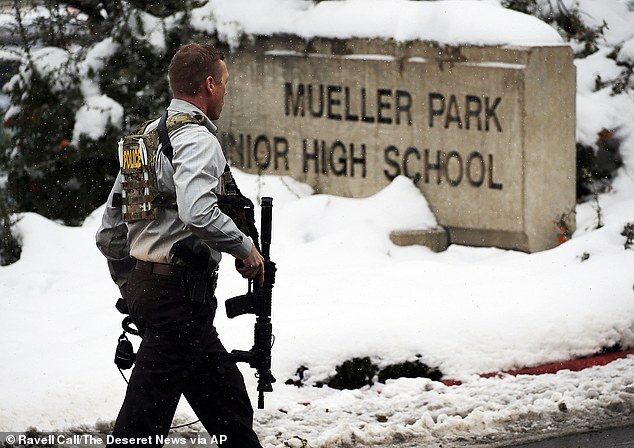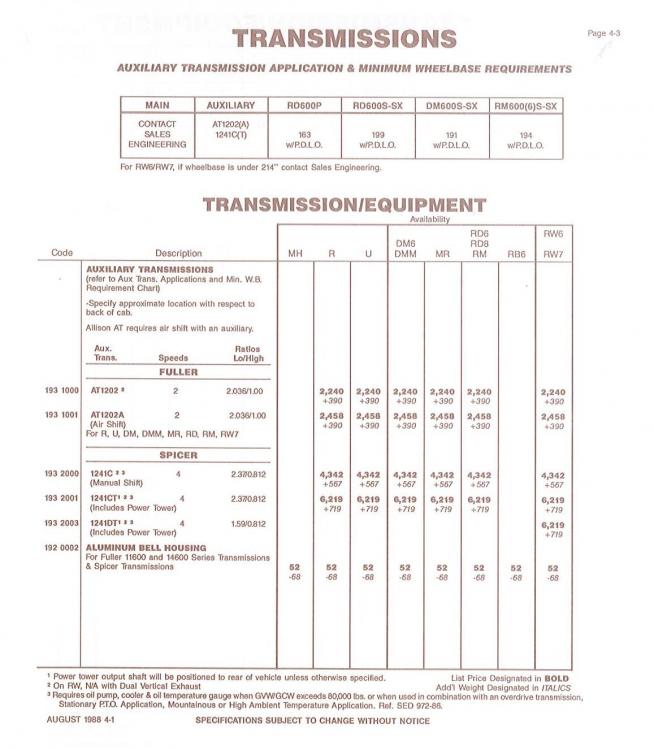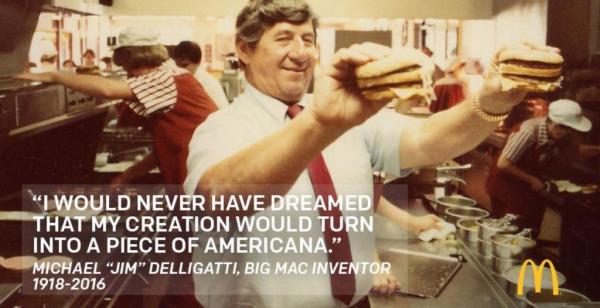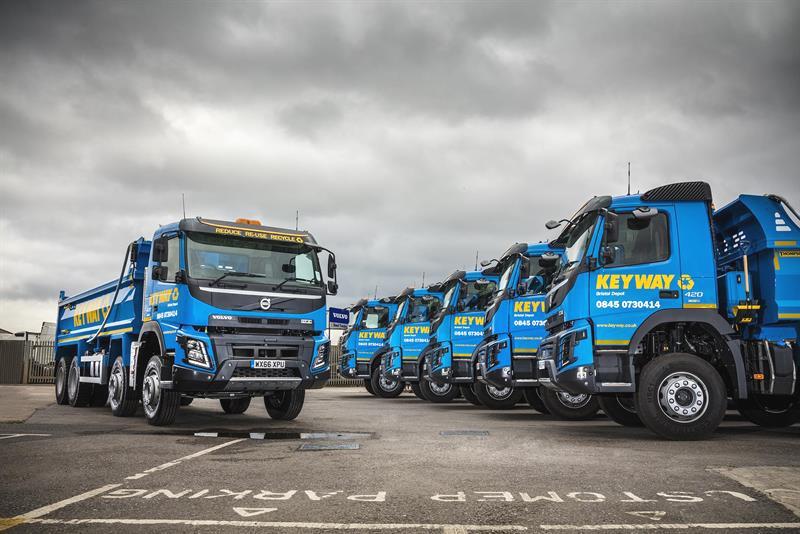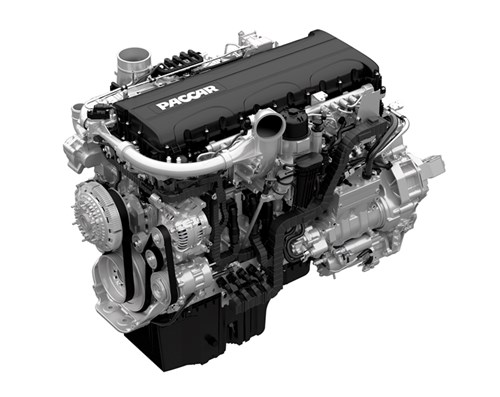
kscarbel2
Moderator-
Posts
17,893 -
Joined
-
Days Won
86
Content Type
Profiles
Forums
Gallery
Events
Blogs
BMT Wiki
Collections
Store
Everything posted by kscarbel2
-
KSL Broadcasting, Salt Lake City / December 1, 2016 A 15-year-old Mueller Park Junior High School student casually walked into a science class shortly after school began Thursday and without saying a word, fired a blast from a shotgun. "I heard it cock, and then I heard the shot go off and I looked up and there was a big hole in the ceiling," said fellow student Dan Fowers. "He looked angry when he came in, like just kind of an angry face, and he just shot at the ceiling without an explanation. He didn’t really say anything," added student Calvin Smith. The student was carrying a 12-gauge shotgun, a .9 mm handgun and two boxes of ammunition — one for each weapon. Moments after firing the round, he was disarmed by his own father and mother who had gone to the school that morning looking for their son because they were concerned about his behavior that day. "They were (also) concerned that there were weapons missing from the house," said Bountiful Police Chief Tom Ross. Investigators say the guns the boy took are normally locked in his parents' safe. He used a long coat to conceal the shotgun as he walked from his house into the school. There were 26 students and a teacher in the classroom the boy walked into. A student and the teacher immediately attempted to talk to the boy, causing him to pause. "I believe those seconds played a big role in the outcome," Ross said. "The suspect did put the gun toward his neck and his intentions may have been to commit suicide." The pause allowed time for the boys' parents — who were two classrooms away at the time looking for him — to run into the science class after hearing the shot and pull him into the hallway. "Both participated in apprehending him," Ross said, while a teacher called 911. Investigators said they did not yet know whether the parents called police or the school about their concerns before arriving at the building. The parents disarmed their son and a Bountiful police officer arrived shortly after and took him into custody. Meanwhile, the school went into lockdown. All of the students were instructed to hide under their desks. As soon as the boy was pulled out of the room, the class locked the door and executed the lockdown drill it had previously practiced. A Bountiful police officer who was already near the school arrived within two minutes. Because it was dispatched as an "active shooter" situation, over 100 officers from law enforcement agencies between North Salt Lake and Layton responded to the school. The boy was booked into the Farmington Bay Detention Center for investigation of two counts of theft of a firearm and two counts of bringing a weapon to school. .
-
Isuzu Commercial Truck of America Press Release / December 1, 2016 .
-
I like the European market Holland Aluminum fifth wheel..........http://ww1.safholland.us/sites/usa/en-US/products/fifthwheels/FWALSeries/Pages/default.aspx I want to learn more about its Meritor-sourced fully independent suspension. When Milton switched in mid-stream from battery/micro-turbine to battery/natural gas fuel cell, he lost me. Clearly, he didn't think things through all the way before he started his sales pitch.
-
You could get a copy from the Mack museum. We didn't build many B-46s, just 473, from 1958 to 1965. It had a short B-67 style hood and was targeted at ready mix operations.
-
Acquired another Mack
kscarbel2 replied to log hauler's topic in Antique and Classic Mack Trucks General Discussion
It has a Scania model DS8 (Mack designation E4-210). Great engine, like most, when properly maintained. The Scania centrifugal filter certainly kept the oil clean. No cartridge to buy, just clean it out and reinstall. It prompted us to create "Centrimax" for the Mack engines. Morgan Millwork ran a huge fleet of R487P straight trucks on the east coast. They loved them. -
Nikola Motor Co. is revealing its Nikola One hydrogen-electric Class 8 tractor at its headquarters in Salt Lake City, Utah. The unveiling is being streamed live below. Allegedly over 600 members of the media, industry partners, customers and government leaders are scheduled to attend the unveiling. “There are many out there that wondered if we would deliver, but today we proudly show off the most advanced semi-truck ever built,” said Trevor Milton, founder and CEO of Nikola. Nikola says Ryder System Inc. will be its exclusive nationwide distribution and maintenance provider. Ryder, which has a network of more than 800 service locations in North America, will provide nationwide sales, service and warranty work. “This relationship is key to expanding our advanced vehicle technology portfolio of innovative solutions,” said Dennis Cooke, president of global fleet management solutions for Miami-based Ryder. “Ryder continually monitors emerging fleet technologies and seeks to establish relationships with companies that are leading innovation within the commercial transportation industry.” Thompson Machinery, a Caterpillar dealer and an early investor in Nikola Motor Co., also will offer sales and service in Tennessee and Mississippi. .
-
James N. Mattis, USMC General (retired) Post: Secretary of Defense Commands held in the U.S. military U.S. Central Command U.S. Joint Forces Command Supreme Allied Commander of Transformation for NATO I Marine Expeditionary Force U.S. Marine Forces Central Command (Middle East excluding Israel) Marine Corps Combat Development Command 1st Marine Division 7th Marine Regiment 1st Battalion, 7th Marines Age: 66 (Born September 8, 1950) Schooling: Mattis graduated from Columbia High School in Richland, Washington, in 1968. He has a Bachelor of Arts degree in history from Central Washington University. Mattis is a graduate of the U.S. Marine Corps Amphibious Warfare School, U.S. Marine Corps Command and Staff College, and the National War College. Background: Mattis was born on September 8, 1950 in Pullman, Washington. Since retirement from the military, Mattis has worked for FWA Consultants and also serves on General Dynamics Board of Directors. In August 2013, he became an Annenberg Distinguished Visiting Fellow at the Hoover Institution, an American public policy think tank and research institution located at California’s Stanford University. Mattis is noted for his intellectualism and interest in military history. Mattis is a life-long bachelor. He has never been married and has no children. Red Flag: In mid-2012, a Department of Defense official evaluating Theranos's blood-testing technology for military use initiated a formal inquiry with the Food and Drug Administration about the company's intent to distribute its tests without FDA clearance. In August 2012, via email, Theranos CEO Elizabeth Holmes asked Mattis, who had expressed interest in testing Theranos's technology in combat areas, to help. Within hours, Mattis forwarded his email exchange with Holmes to military officials, asking "how do we overcome this new obstacle." Since 2013, Mattis has been a Theranos board member, a controversial Silicon Valley biotech company with criticized corporate governance practices. In a July 2013 letter from the Department of Defense approving his possible employment by Theranos, Mattis was given permission with conditions. He was cautioned to do so only if he did not represent Theranos with regards to the blood testing device and its potential acquisition by the Departments of the Navy or Defense. Theranos is under criminal investigation. http://www.wsj.com/articles/theranos-is-subject-of-criminal-probe-by-u-s-1461019055 Instead of attributing the Middle East’s atrocities to radical Islam, Mattis blames regional anti-Western hostility on the perception of the injustice of oppression suffered by Palestinians under the Israeli occupation. At the 2013 Aspen Security Forum, speaking about the Israeli-Palestinian situation, Mattis said “I paid a military security price every day as the commander of CENTCOM because the Americans were seen as biased in support of Israel.” Calling Israeli control of Judea and Samaria “unsustainable,” Mattis warned that Jewish “settlements” could turn Israel into an “apartheid state.” Before deploying to Iraq, Mattis ensured his troops were given courses on Arab culture and cultural sensitivity classes. Note: Mattis will need Congress to pass new legislation to bypass a federal law stating that defense secretaries must not have been on active duty in the previous seven years. The National Security Act of 1947 states a general must wait 10 years from leaving active duty before becoming defense secretary. An exception was granted on a one-time basis for Gen. George C. Marshall in 1950, with lawmakers saying in special legislation at the time that it was the “sense of the Congress that after General Marshall leaves the office of Secretary of Defense, no additional appointments of military men to that office shall be approved.”
-
Can you post your truck's line sheet?
-
Okay, RWS721LS-1528. You should see "1M2V120C4FM001528" also stamped on the outside of the right frame rail by the steer tire. Now, your dealer can take that, look up the 1QH and 1QK front axle and front spring arrangements respectively, and tell you what axle and springs you have.
-
The truck's serial number (VIN) is also stamped on the outside of the right-hand frame rail. You can lean over the right steer tire and see it. This is the same number on the driver's door-mounted vehicle identification plate. But the model number is not stamped on the frame. A dealer needs the model number, and the last 5 digits of the serial number, to research the truck.
-
Queensland to host Australia’s 'largest' automated vehicle trial
kscarbel2 replied to kscarbel2's topic in Trucking News
So Queensland taxpayers, who are NOT asking for autonomous vehicles, have to pay the bill for this farce. And Bosch, who stands to profit from providing the autonomous vehicle technology, is merely “supporting” the show (Bosch people stand by warmly clapping and smiling). -
Australasian Transport News (ATN) / November 30, 2016 Bailey says success of such trails depends upon adapting existing traffic systems with new technologies Queensland has announced plans to host the biggest automated vehicle pilot program that will see around 500 fleet and public vehicles test the concept of connected and automated driving (C-ITS) technology in Ipswich. The four-year Cooperative and Automated Vehicle Initiative (CAVI) project will be funded by the state government, and the Motor Accident Insurance Commission and supported by Bosch Australia, Ipswich City Council and Queensland University of Technology’s Centre for Accident Research and Road Safety – Queensland (CARRS-Q). The state government plans to engage with transport industry members and other relevant stakeholders to adapt the existing systems, infrastructure and data to innovative transport technologies. The on-road testing phase of the project is expected to kick off in 2019. The subjects of platooning, driverless vehicles and automated vehicle trials have gained momentum in Australia, with other states including Western Australia and South Australia planning similar trials in the near future. Earlier this month, the National Transport Commission (NTC) released automated vehicle regulation reform roadmap, which recommends a phased reform program to facilitate such trials. Queensland roads and road safety minister Mark Bailey says the state transport department is working with Bosch to secure its "highly-automated driving vehicle", which is co-sponsored by the Victorian government, for the trial. "The Queensland Government’s CAVI project is another example where industry and government will work together to trial and validate the benefits these new technologies will bring to the market," Bosch Australia regional president chassis systems control Mark Jackman says. "Project’s such as these are not just vital for the advancement of road safety and public awareness but also for the further development of technical expertise and capability of Bosch Australia engineers." The vehicles involved in the trial will be retrofitted with C-ITS devices that will provide safety warnings to the driver about current road conditions that may not visible to them at that point on the road. "These C-ITS devices work by providing safety warnings to the driver about a range of conditions – for example, a pedestrian crossing at a signalised intersection, a red light runner or a queue ahead that isn’t visible to a driver," Bailey says. "Our interest in testing these vehicles is to help understand the implications for our infrastructure and drivers, and the improvements to automated vehicle performance when the vehicle can talk to other vehicles and infrastructure. "These rapidly developing technologies have the potential to significantly reduce crashes and crash-related gridlock, as well as reduce vehicle emissions and fuel use over coming decades. "While industry is leading the development of advanced vehicle technologies, the success of these will rely upon connecting to our existing traffic systems." Member for Ipswich Jennifer Howard says the test-bed will be available for use by industry, academics and governments to continue to test new technologies. Member for Ipswich West Jim Madden says the transport department’s move to the planning phase of the pilot "will have a strong focus on safety".
-
-
The vehicle identification plate for your truck, with your model and serial (VIN) number, is located at the rear of the driver's door.
-
New ALE trailers shift 231-tonne transformer
kscarbel2 replied to kscarbel2's topic in Trucking News
An earlier move. . -
Wilbur Ross Jr. (nicknamed the “King of Bankrupcty”) Post: Secretary of Commerce Previous experience: None Age: 79 (born November 28, 1937) Schooling: Ross attended the elite Catholic college preparatory Xavier High School in Manhattan, later earning a Bachelor of Arts/Science degree at Yale University (also his father's alma mater). Ross’s faculty adviser at Yale helped him get his first summer job on Wall Street. He earned his MBA at Harvard Business School. Marriages: Judith (Nodine) Ross (May 26, 1961-October 1995, divorced); Betsy (McCaughey) Ross (December 7, 1995-August 2000, divorced); Hilary (Geary) Ross (October 9, 2004-present). Background: An American investor, and former banker, known for restructuring failed companies in industries such as steel, coal, telecommunications, foreign investment and textiles. He specializes in leveraged buyouts and distressed businesses. As of August 2014, Forbes lists Ross having a net worth of $2.9 billion. Ross was born in Weehawken, New Jersey, and grew up in an affluent family. His father, Wilbur Louis Ross, Sr., was a lawyer who later became a judge, and his mother, Agnes was a school teacher. 1976-2000 - Ross works 25 years for the investment bank Rothschild Inc. During his tenure, he becomes a top bankruptcy adviser. January 1998 - Ross pledges $2.25 million towards then-wife and Lt. Governor Betsy McCaughey Ross's campaign for Governor of New York. He withdraws the funding in September and files for divorce in November. 2000 - Purchases a small fund he started at Rothschild and opens his own private equity firm, WL Ross & Co. LLC. 2002 - Establishes the International Steel Group (ISG), with himself as chairman of the board, through a series of mergers and acquisitions starting with Bethlehem Steel Corp. December 2003 - ISG goes public. 2004 - Ross forms the International Coal Group (ICG) after purchasing the assets of Horizon Natural Resources in a bankruptcy auction. October 2004 - Merges ISG with Mittal Steel for $4.5 billion. January 2, 2006 - A West Virginia explosion at the Sago Mine, operated by ICG subsidiary Wolf Run Mining Co., leads to the death of 12 miners. Families of the dead and Randal McCloy, the lone survivor, sue ICG and WL Ross & Co. claiming negligence. All of the lawsuits are settled by November 2011. April 2010 - Purchases a 21% stake in Richard Branson's Virgin Money. In November 2011, Ross helps Branson fund a successful bid for the British bank Northern Rock. August 2, 2010 - In an interview with Charlie Rose, Ross states that he's fine with higher taxes on the wealthy as long as the government puts the money to good use. June 2011 - Arch Coal, Inc. acquires International Coal Group (ICG) for $3.4 billion. September 2011 - W.L. Ross & Co. is among a group of five American and Canadian investors who purchase a 34.9% stake in the Bank of Ireland. Ross' share is 9.3%. March 2016 - Ranked number 595 on the annual Forbes World's Billionaires list, with an estimated net worth of $2.9 billion. March 21, 2016 - Nexeo Solutions, a chemical distribution company, announces their merger agreement with W.L. Ross Holding Corporation. The merger is valued at $1,575 million. August 24, 2016 - The SEC announces that W.L. Ross & Co will pay a $2.3 million fine for failing to properly disclose fees it charged. The firm refused to admit to any wrongdoing. “Part of the reason why I’m supporting Trump is that I think we need a more radical, new approach to government – at least in the U.S. – from what we’ve had before,” Ross explained. “I think the reason why the Trump phenomenon has become so important … is because middle class and lower middle class America has not really benefited by the last 10 to 15 years of economic activity and they’re sick and tired of it and they want something different.” Wilbur Ross Jr. / CNBC / June 15, 2016 . . -------------------------------------------------------------------------------------------------------------- Ross escalates Trump trade criticism against Beijing The Financial Times / January 18, 2017 Commerce Secretary nominee labels China ‘most protectionist’ major economy The billionaire businessman set to oversee trade policy for President Trump has hit back at Chinese leader Xi Jinping and his bid to become the leading advocate for globalization, calling China the “most protectionist” major economy in the world. The criticism by Wilbur Ross, made at his confirmation hearing to become Trump’s commerce secretary, is the latest in criticism from Trump and his economic advisers against Beijing which has already sparked concerns of a US-China trade war. “They talk much more about free trade than they actually practice,” Ross told the Senate commerce committee on Wednesday. “China is the most protectionist country of very large countries.” Ross’s remarks come a day after President Xi used his appearance at this year’s World Economic Forum in Davos to push back against rising protectionism, widely seen as an effort by the Chinese leader to takeover international leadership in the global economy from the United States. Ross is expected to play a much more prominent role in setting US trade policy than his predecessors at commerce. Trump aids say the former investment banker will lead the new administration’s trade team. That would put the 79-year-old in charge of delivering the “America First” agenda that was at the center of Trump’s presidential campaign. Ross has been Trump’s most outspoken critic of existing international trade relations, saying previous administrations have engaged in “dumb trade” with China and Mexico. At the hearing, Ross said he was a free trader who would be focused on trying to increase US exports to boost economic growth. “I am not anti-trade. I am pro-trade,” Ross said. “But I am pro-sensible trade, not pro-trade that is to the disadvantage of the American worker and the American manufacturing industry.” Despite Trump’s recent threats against automakers that they would face import levies unless they built cars for the US market inside the US, Ross said he was mindful of the lessons of the 1930s when US-imposed tariffs helped extend and deepen the Great Depression. “Tariffs do have a useful role in correcting inappropriate practices,” Ross said. But he added: “I am keenly aware of [1930s-era tariff acts] and the effect that it had. If nothing else we can learn the lessons of history. If it didn’t work very well then it likely wouldn’t work very well now.” Trump threatened during the campaign to impose a 45 percent tariff on Chinese imports. He has also threatened to impose a 35 percent “border tax” on imports from Mexico. Those threats, Ross told senators, had been useful in signaling to countries like China and Mexico that “change is coming” and laying the ground for negotiations. “When you start out with your adversary understanding that he or she is going to have to make concessions, that’s a pretty good background to begin,” he said. Ross said his first priority would be to renegotiate the North American Free Trade Agreement (NAFTA) with Canada and Mexico, as Trump promised during the campaign. The Trump administration is expected to notify those countries within days that it wants to reopen the pact. But he repeatedly singled out China as a major offender in the global economy. “It’s a little weird that we have very low tariffs and China has very high tariffs,” Ross said. “That seems to me to be a bit of an imbalance. It’s one thing to talk about free trade. We would like our trading partners to practice more free trade.” A third of China’s state-owned companies were on the verge of failure, Ross said, supported only by low-cost loans from state-run banks and other subsidies. China also was at the centre of global problems of overcapacity in steel and other industries. Ross promised to take a more aggressive approach towards anti-dumping cases, raising the possibility that he would become the first US commerce secretary since the 1990s to take advantage of rules allowing the “self-initiation” of anti-dumping cases normally brought by industry. Ross also said the Trump administration would crack down further on dumping by countries such as China, blaming it for a collapse in global prices for steel and aluminum.
-
Reuters / November 30, 2016 Republicans in Congress hope to convince Trump to support an untested strategy of using the tax code to promote exports while slashing corporate taxes, framing it as a way to fulfill his campaign promises to restore blue-collar jobs. The plan would be one way to help Republican lawmakers reconcile their long-standing goal of tax cuts with the often populist campaign rhetoric of Trump, who has attacked the North American Free Trade Agreement (NAFTA) and other trade deals as bad for U.S. workers. Critics say it risks running afoul of global trade rules and increasing costs for U.S. consumers, and that any export gains could be short-lived if the strategy causes the dollar to strengthen, wiping out any price advantage for U.S. products in international markets. The export-focused "border adjustability" strategy is part of a larger package of proposals offered in congressional Republicans’ “A Better Way” economic plan from House Speaker Paul Ryan and House tax committee chairman Kevin Brady. "If we have a border adjustable tax system, that can solve a lot of these trade issues that Trump is talking about," says economic analyst and Trump adviser Stephen Moore. “You’re going to tax what’s imported and not going to tax what’s exported. So we’re going to reduce the trade deficit and we’re going to have more companies come in here,” Moore says. The strategy would be implemented by making revenue from sales to non-U.S. residents non-taxable, while preventing importers from deducting the cost of goods bought from non-residents. Brady says border adjustability would "virtually eliminate" any tax incentive for U.S. companies to move operations overseas and encourage foreign investment to return to the United States. "We’ve got a great argument, I think,” he said. Steven Mnuchin, Trump's pick for U.S. Treasury secretary and co-author of the president-elect’s tax plan, described tax reform on Wednesday as “something that happens absolutely within the first 90 days of this presidency.” Wilbur Ross, Trump's nominee for commerce secretary, says the Trump administration’s aim would be to increase exports in part by getting rid of “non-tariff” barriers. The perceived winners under a border adjustability approach would include U.S. manufacturers that export heavily, while large-volume importers, such as U.S. retailers, could be hurt. That distinction was already dividing corporate lobbying groups. While retailers support an overhaul of the tax code, "the tax on imports proposed in the House blueprint is cause for concern for retailers," said Christin Fernandez, spokeswoman for the Washington-based Retail Industry Leaders Association whose members include Wal-Mart, Home Depot and Target. Some version of border adjustability could attract support from Democrats. Senator Ben Cardin, a Maryland Democrat who sits on the Senate Finance Committee and the panel’s tax subcommittee, said he strongly favors the idea. But he called the emerging House plan "very, very questionable" because it would use tax on corporate income rather than a consumption tax. Tax lawyers and other experts have said such an approach risks violating long-standing world trade rules that allow countries to adjust their trading positions through indirect taxes, such as a sales tax, but not with direct taxes like the U.S. corporate tax. "It would lead to uncertainty on how it would be treated internationally. And that’s bad for business," says Cardin. Brady has said border adjustability would be acceptable to the World Trade Organization. Border adjustability is only one component of the "A Better Way" blueprint. It would also slash the corporate income tax rate to 20 percent from a top rate of 35 percent; repeal the corporate alternative minimum tax; and let businesses write off capital investments immediately. Altogether, it’s estimated that the House Republicans' corporate tax plan would reduce U.S. corporate tax revenues by about $891 billion over 10 years, perpetuating a long-term decline in the corporate tax take. Combined with an equally ambitious package of individual income tax cut proposals put forward in the "Better Way" package, the Republican plan could boost the federal deficit by about $3.7 trillion over a decade. Advocates of border adjustability note that U.S. trading partners including China use value-added taxes (VAT) to favor exports over imports and say the House proposal would level the playing field for U.S. companies. But some tax experts have questioned how effective it would be, saying that the increased demand abroad for cheaper U.S.-made goods would boost the dollar's value and cancel out gains for exporters. Still, supporters of the plan believe it could win the favor with Trump, who has railed against U.S. companies that have shifted production abroad and scaled back U.S. operations. Trump has already ruled out U.S. participation in the ambitious Trans-Pacific Partnership (TPP) trade deal and has vowed to renegotiate or quit NAFTA. "When Trump understands how the blueprint works, particularly the border adjustability provision, which will create a huge incentive to make stuff in the United States, I think he'll be delirious," said Ken Kies, one of Washington's most influential corporate tax lobbyists who represents Microsoft, General Electric, Pfizer and Caterpillar.
-
U.S. to Forgive at Least $108 Billion in Student Debt in Coming Years The Wall Street Journal / November 30, 2016 GAO report offers first full cost estimate of debt-relief programs, berates Education Department over accounting methods The federal government is on track to forgive at least $108 billion in student debt in coming years [at the taxpayer’s expense], as more and more borrowers seek help in paying down their loans, leading to lower revenues for the nation’s program to finance higher education. The Government Accountability Office disclosed the sum Wednesday in a report to Congress which for the first time projected the full costs of programs that set borrowers’ monthly payments as a share of their earnings and eventually forgive portions of their debt. The GAO report also sharply criticized the government’s accounting methods for its $1.26 trillion student-loan portfolio, pointing to flaws that have led it to alter projected revenues significantly over the years. The government says it still expects the program to generate a profit over the long term, but it has repeatedly trimmed expectations for revenues. President Barack Obama has promoted income-driven repayment plans—passed by Congress in the 1990s and 2000s—to stem a sharp rise in borrowers defaulting on their loans since the recession. Enrollment in such plans has more than tripled over the past three years to 5.3 million borrowers, who owe roughly $355 billion. Ted Mitchell, undersecretary at the Education Department, said such programs “are helping millions of borrowers successfully manage loan repayment, particularly those for whom standard repayment may prove challenging.” He added that the administration has proposed changes to reduce costs. Mr. Obama, for example, has called for capping how much debt public-service workers can have forgiven. The most generous version of income-driven repayments caps a borrower’s monthly payment at 10% of discretionary income, which is defined as adjusted gross income above 150% of the poverty level. That formula typically lowers monthly payments of borrowers by hundreds of dollars. Public-service workers—those employed by a government agency or at most nonprofits—have balances forgiven after 10 years, tax-free. Private-sector workers have balances forgiven in 20 or 25 years, with the forgiven amount taxed as ordinary income. President-elect Donald Trump said during his campaign he supported the idea of helping student-loan borrowers. He has proposed setting payments at 12.5% of income and forgiving balances after 15 years [rewarding irresponsibility]. He has also suggested winding down the federal student loan program and shifting lending to the private sector. Growing evidence suggests many of the most hard-pressed borrowers—college dropouts who owe less than $10,000—aren’t taking advantage of the programs, while workers with graduate degrees, such as doctors and lawyers who don’t necessarily need help, are. GAO figures suggest the average balance of borrowers in income-driven repayment plans stands at $67,000. That sum suggests a disproportionate share of those benefiting from the plans are graduate-degree holders, since the government caps lifetime borrowing from federal programs for undergraduates at $57,500. It doesn’t limit how much grad students can borrow. And graduate-degree holders typically have higher incomes and have low rates of unemployment, Labor Department data show. There are still about 8 million Americans in default on their student loans, and the number of defaults among borrowers who recently left school has come down only slowly. Meanwhile, Senate Budget Committee Chairman Mike Enzi (R., Wyo.), who ordered the GAO study, has criticized the Obama administration’s use of executive authority to sweeten terms of the repayment plans, which he said would add to the national debt. “This Administration has been manipulating the terms of the student loan program without the consent of Congress, while shirking its statutory duty to carefully assess the cost impact of those changes,” said Enzi, adding that he was considering legislation to force changes in the government’s accounting methods. In addition to debt forgiveness under income-driven repayment programs, the administration is also moving to forgive loans for borrowers who can show they were lured to enroll at schools—mostly for-profit colleges—that used deceptive advertising. Income-driven repayment plans are also causing concern that as more students become aware of the benefits, they will become less sensitive to tuition increases, enabling universities continually to raise tuition ultimately at taxpayer expense. Higher education costs have increased by an average of 5.2% a year in the past decade, far faster than inflation, which has been running at under 2%. And some borrowers with graduate-school loans are refinancing their debt at lower interest rates with private lenders such as SoFi. Congress, through legislation, has set higher interest rates for grad students than undergrads, to ensure the programs don’t lose money. When private lenders pick off those borrowers, the surpluses dwindle. The GAO estimates that $137 billion of the roughly $355 billion owed under income-driven repayments won’t be repaid. Most of it—the $108 billion disclosed Wednesday—would be forgiven because of borrowers fulfilling their obligations under the plans. The other $29 billion will be written off because of disability or death, the GAO projects, the only other circumstances under which the government takes a loan off its books. The government can garnish wages and Social Security checks for those in default. And that $108 billion only covers loans made through the current school year. The overall sum could continue to grow alongside enrollment increases. The GAO said it could take 40 years to know the full costs of the programs. The GAO report also criticizes how the Education Department has produced budget estimates for the loan program. For example, it said the department has failed to account for inflation when estimating borrowers’ future earnings. And it said the agency failed to account for further increases in enrollment in income-driven repayment plans.
-
The Wall Street Journal / November 30, 2016 As a McDonald’s Corp. franchisee in the Pittsburgh area, Jim Delligatti in the mid-1960s believed the burgers-and-fries menu needed something bigger and jazzier. He came up with the Big Mac, tested it in one of his restaurants and saw it swiftly become a national sensation, heralding an era of ever-increasing reliance on novelty in fast food. Mr. Delligatti died Monday at his home in Fox Chapel, a suburb of Pittsburgh, his family said. He was 98 years old. He came up with the idea for the Big Mac in 1965 and first served it at his Uniontown, Pa., McDonald’s outlet in 1967. The hamburger features two beef patties, a mildly tangy sauce, lettuce, cheese, pickles and onions slathered over a soft sesame-seed bun sliced into three layers. The original price was 45 cents, compared with an average of about $5 today. McDonald’s put the Big Mac on its national menu in 1968. Mr. Delligatti acknowledged that the Big Mac was derived from double-deck hamburgers made popular by rival fast-food restaurants. “This wasn’t like discovering the lightbulb,” he told the Los Angeles Times in 1993. “The bulb was already there. All I did was screw it in the socket.” Even so, his initiative helped launch McDonald’s on a long-running diversification of a menu once limited to little more than basic hamburgers, fries, shakes and soft drinks. The corporate headquarters initially opposed Mr. Delligatti’s plan to use a triple-deck bun with sesame seeds, said Michael Delligatti, one of his sons. But the elder Mr. Delligatti went ahead with the new bun anyway. Without it, he thought, the Big Mac would be too sloppy. In recent years, the Big Mac’s appeal has faded as McDonald’s has struggled to find ways to entice customers back from rivals whose food is widely seen as fresher, healthier and hipper. The Big Mac “has gotten less relevant,” a top McDonald’s franchisee wrote in a memo to other operators in July. Only one in five millennials has tried a Big Mac, the memo said. “We still sell lots of Big Macs,” said Michael Delligatti. He added that he didn’t oppose tinkering with the original formula, such as by adding Sriracha sauce. Mr. Delligatti didn’t receive royalties on Big Mac sales. “All I got was a plaque,” he once said. Michael James Delligatti was born Aug. 2, 1918, in Uniontown, about 45 miles south of Pittsburgh. His father worked as a shoe cobbler and candy maker. The younger Mr. Delligatti attended school in Uniontown and in Fairmont, W.Va., then served in the U.S. Army in Europe during World War II. After the war, he hitchhiked to California and found work in drive-in restaurants there. In 1953, he and a partner opened Delney’s Drive-In Restaurant in Pittsburgh. Two years later, Mr. DelliGatti met Ray Kroc, founder of McDonald’s, at a restaurant trade show in Chicago. He became a franchisee of McDonald’s in 1957, opening an outlet in Pittsburgh, the first in western Pennsylvania. Mr. Delligatti is survived by his wife, Ellie, two sons, five grandchildren and eight great grandchildren. His two sons and two of his grandchildren are McDonald’s franchisees. In all, the family owns and operates 21 McDonald’s restaurants in western Pennsylvania. In 2007, the family opened a McDonald’s Big Mac Museum Restaurant in North Huntingdon, Pa., near Pittsburgh. Mr. Delligatti also innovated by coming up with an early version of the chain’s breakfast offerings—hotcakes and sausages initially aimed at steelworkers returning home from overnight shifts. He wasn’t alone among franchisees in coming up with a hit product. McDonald’s said other franchisees invented the Egg McMuffin and the Filet-O-Fish. Mr. Delligatti’s charitable contributions included backing for the Ronald McDonald House in Pittsburgh, which provides a refuge for families traveling to the area to get medical care for their children. .
-
New Trump hires pledge tax and regulation shake-up The Financial Times / November 30, 2016 Mnuchin and Ross vow to stand firm on campaign promises as Democrats decry choices Donald Trump’s new economic team has vowed to push ahead with his far-reaching policy proposals to slash taxes, loosen bank regulation and shake up US links with China and other trading partners. The pledges to stand firm on Trump’s bold campaign promises came as the president-elect on Wednesday nominated former Goldman Sachs banker Steven Mnuchin as Treasury secretary and confirmed the private equity mogul Wilbur Ross as his choice for commerce secretary. Mnuchin told CNBC Americans should expect the “largest tax change since [Ronald] Reagan”. The two Wall Street insiders, set to be co-heads of the Trump economic team, said Trump’s policies would return the US economy to a sustained annual growth rate of 3-4 per cent while lifting wages and creating more “good jobs”. Trump’s transition team also nominated Todd Ricketts, co-owner of the Chicago Cubs baseball team, as deputy commerce secretary. Mnuchin, 53, a hedge fund manager and Hollywood movie producer, will play a central role in transforming tax, Wall Street and the US’s international financial ties for a president who has embraced the private sector and been sceptical of globalism. Democrats quickly condemned his selection, portraying Mnuchin as a creature of Wall Street who “preyed on” homeowners during the last financial crisis and would not put the interests of ordinary Americans first. Senator Sherrod Brown, a senior Democrat, said: “This isn’t draining the swamp — it’s stocking it with alligators.” Mnuchin said on CNBC the Trump administration would create “huge economic growth” by pushing ahead with its plan to reduce the US federal corporate tax rate from 35 per cent to 15 per cent, a goal it will need to negotiate with Congress. On personal taxation he disputed the findings of analysts who say most of the benefits of Trump’s tax plan would go to the wealthy, saying “there will be no absolute tax cut for the upper class” because lower rates would be offset by caps on the deductions people can claim. But Kyle Pomerleau of the Tax Foundation, which publishes research on tax policy, said the richest 1 per cent of Americans would still get a net cut. “The Trump administration would need to alter the current tax plan to satisfy the goal of no net tax cut for the top 1 per cent,” he said. Managing US-China ties will be one of the Treasury secretary’s biggest challenges. While Mnuchin did not drop Trump’s pledge to label China as a currency manipulator in his first 100 days, he made clear that he would want the US Treasury to investigate first. “If we determine that we need to label them as a currency manipulator that’s something the Treasury would do,” he said. Under current standards set by a 2015 law the US Treasury has said China does not meet the definition of being a currency manipulator. Mnuchin would also be the third Treasury secretary after Robert Rubin and Hank Paulson to have worked at Goldman Sachs. He has known Mr Ross, who was interviewed alongside him, for three decades. On trade, Ross said the president-elect’s threat to impose defensive tariffs on Chinese and Mexican imports would not be a first resort but part of the US’s negotiations as it aimed to boost American exports. Rejecting the “protectionist” label applied to Trump, he said: “It’s not really something that’s meaningful. There’s trade, there’s sensible trade, and there’s dumb trade. We’ve been doing a lot of dumb trade. And that’s the part that’s going to get fixed.” Following Trump’s vow to dismantle the Dodd-Frank reforms imposed on Wall Street after the last financial crisis, Mnuchin — who bought a collapsed mortgage lender in 2009 — said his priority would be “to strip back parts of Dodd-Frank that prevent banks from lending”. He refused to comment on whether Janet Yellen, the Federal Reserve chair, should finish her term after being sharply criticised by Trump during the election campaign. He said, however, that “she’s done a good job”. While Treasury secretaries usually steer clear of commenting on monetary policy to protect the Fed’s independence, Mnuchin said interest rates would likely stay low for a few years, but added that the recent rise in bond yields made sense. Mnuchin, who chairs the Dune Capital hedge fund and Dune Entertainment Partners, left Goldman 15 years ago to produce films in Hollywood. Trump said he was a “world-class financier, banker and businessman” who would play a "key role in developing our plan to build a dynamic, booming economy that will create millions of jobs”. Mnuchin pushed back at criticism from Democrats that he had taken advantage of homeowners since the financial crisis by buying IndyMac, the collapsed mortgage lender. He said that the move to scoop up the group “saved a lot of jobs” and that as part of the pact, he “bought the worst mortgage portfolio in the history of time”. He added that “all the loans we had to foreclose on we did not originate”. Separately, Mnuchin told Fox Business that it made“no sense” for the government to continue owning the mortgage insurers Fannie Mae and Freddie Mac, which Washington bailed out in the 2008 financial crisis. “We’ve got to get Fannie and Freddie out of government ownership,” he said: “In many cases this displaces private lending in the mortgage markets.” High-profile US investors including John Paulson, Bill Ackman and Richard Perry amassed big stakes in the two companies, and sued over the government’s 2012 “sweep” of their profits. The value of their positions had been dropping for years, until Mr Trump’s election spurred speculation that he would relax the government stranglehold. Common shares in Fannie and Freddie have more than doubled, with each rising more than 44 per cent on Wednesday, boosting hedge funds locked in the trade: Mr Perry’s Perry Capital said in September it would shut down. But for Mr Paulson and Mr Ackman, whose funds have both dropped in value by more than 15 per cent this year, the move is providing a much-needed fillip. ------------------------------------------------------------------------------------------------------------------------------------------------- Key quotes from Steven Mnuchin from CNBC interview Defending his company’s role buying IndyMac during the 2007 financial crisis We bought the worst mortgage portfolio in the history of time. On his role as a Democrat donor in earlier elections Like the president-elect I lived in New York and gave money to certain Democrats . . . I didn’t say I backed them. I gave money to them. On the state of the economy The problem has been for the last eight years, there’s been no economic growth. What we saw travelling with the president-elect, at all these rallies, is that for the average American worker they’ve gone nowhere. Our job is to make the average American worker have wage increases and have good jobs. That’s the priority of this administration.” On Janet Yellen Look, I think she’s done a good job at the Fed. I am not going to comment on whether she should or she shouldn’t (continue). On China If we determine that we need to label them as a currency manipulator, that’s something the Treasury would do. On Dodd/Frank The number one problem with Dodd/Frank is it’s way too complicated and it cuts back lending. So we want to strip back parts of Dodd/Frank that prevent banks from lending . . . That will be the number one priority on the regulatory side. On losing friends in California when he joined the Trump team This was never a gamble from my perspective. I’ve known the president-elect for over 15 years. I believed in his policies and I thought he would win. But I did this because I believed in it, despite the fact there were a lot of people in California and New York that wanted to stop being friends. They’ve all come back. .
-
Transport Engineer / December 1, 2016 Keyway has added 24 Volvo FMX tippers to its 70 strong tipper truck fleet. The plant hire, recycling and earth moving specialist also took delivery of two STGO Cat2 (up to 80 tonnes) 500bhp Volvo FH tractor units and two FM 8x2 rigids with King beavertail bodies. All the South West-based operator’s new tippers were specified with day cabs and B-Ride high rear suspension. “We’ve not traditionally run Volvo trucks, but the automated manual I-Shift transmission and incredible support from [dealer] Truck and Bus Wales & West convinced us this was the way to go,” comments Keyway managing director Eamonn McGurk, adding that he is “extremely happy” with the result. “The Volvo FMX with 420bhp engines and Thompsons or Boweld bodies - both with cab operated tailgates - are proving to be a solid investment, offering good fuel economy as well as winning praise from our drivers,” he continues. McGurk says safety was also critical for all his new trucks, and reckons that features on the FMX, FH and FM ticked all the boxes. “The all-round visibility is excellent and we’ve bolstered this with both sensor and camera systems,” he explains. “In future, we will add factory-fit low-level nearside windows too, as we think this is a very positive development in truck design.” .
-
Transport Engineer / December 1, 2016 ALE “widening trailers” used to move a 231-tonne transformer from Stafford to Ellemere Port. The transformer was transported using 12 axle lines of the new widening trailers, narrowed in, with an AL34 girder frame. The trailers were launched in May this year and can be narrowed in or widened to 4.3 meters (14.1 feet) while loaded. The heavyweight cargo was moved in three stages over three days, from Stafford to Congleton, then to Kelsall and, finally, to Ellesmere Port for onward shipment. Tom Irvine, senior project manager, says that narrowing the trailers and using them under a girder frame showcased their flexibility for different transport applications. Related reading - http://www.bigmacktrucks.com/topic/37559-ale-introduces-new-prime-mover/#comment-265043.
-
Scania Group Press Release / November 30, 2016 South African mining transport company Reinhardt Transport explains how its partnership with Scania has improved their business. .
-
Kenworth Truck Company Press Release / November 30, 2016 Kevin Keeney feels he hit the jackpot when it comes to trucks and productivity. In the past few months, the vice president of Arcadia, California-based Food Express has put into service Kenworth T680s powered by the Paccar [DAF] MX-11 engine, and has seen a dramatic change. “It’s been a trifecta in improvements,” Keeney said. “There’s less weight so we can carry 1,500 pounds more product; increased fuel economy of up to 1 mpg; and driver acceptance that we’ve never seen before. With the success we’ve experienced with our initial order of 26 T680s, we have another 26 on order now. We see the Kenworth T680 as our new flagship.” Food Express has made its mark hauling flour, malt barley, corn starch and sugar throughout states west of the Rockies. With a fleet of 200 tractors and 360 trailers, the company has offices and terminals in six locations. Its business is divided into local hauls – such as in the Phoenix area – and in longer hauls originating from Southern California and Arizona. The initial T680s, purchased through Inland Kenworth – Montebello and financed through Paccar Financial, are in service in Phoenix and Fresno. In addition to T680 day cabs, Keeney said the company also purchased T680s with 40-inch sleepers. “That’s as a safeguard for our longer runs,” he said. “It gives our drivers space for naps, or downtime during weather delays. The 40-inch sleeper is the perfect size, and is very light in weight compared to other sleeper units in our fleet.” According to Keeney, in early 2016 the company decided to offer a challenge to five truck makers. “We wanted to start with a clean slate and find a truck that could lower our weight and offer other improvements,” Keeney said. “So, we worked with five dealerships and challenged them to build a truck that would fit our needs. To make it an apples-to-apples comparison, if we found a component we liked and wanted to incorporate it, we shared it with all the dealers.” The end result – Food Express chose the T680 day cab. “It was more than 1,500 pounds lighter than the previous generation of trucks we had in service,” said Keeney. “The biggest contributor to the weight loss was the MX-11 engine, which provides the power and torque we need, in a package that saves us 400 pounds.” The T680 day cabs, in a 6x2 configuration, use the MX-11 engine spec’d at 430 hp with 1,550 lb.-ft of torque and driven through an Eaton Fuller Advantage™ 10-speed automated manual transmission (AMT). Since Food Express charges by the truckload, Keeney said he uses the weight savings as a value-added service for his customers. “They now get more payload hauled, and we view it as a customer retention tool,” he said. “If we can haul more than our competitors, our customers see great value in that, and in our company.” While the weight savings fills the customer satisfaction ‘bucket’ for its clients, Food Express is reaping rewards of its own in terms of vehicle performance and reduced operating costs. “The MX-11 is huge for us,” he said. “Not only are we seeing better fuel economy, but the power in that engine is remarkable. Paccar did a wonderful job with this engine – we’ve been very impressed. We have the Grapevine Hill that borders the San Joaquin Valley and Los Angeles. It’s a five-mile hill with a 6 percent grade and the T680 with MX-11 engine averages 3 mph faster up that hill than our other trucks. Impressive. That shows how potent that engine is.” The T680 has been a hit with drivers, according to Keeney. “The drivers love the truck – the wide cab gives them lots of room and the visibility is so much greater. And, it’s so quiet. The combination of the Paccar MX engine and the insulation package really means a nice driver environment. If you were to poll our drivers, the T680 would be the truck that comes out on top. The Kenworth brand itself lends itself to pride and driver satisfaction. The quality of the T680 just puts it over the top.” The Keeney family has roots deep into trucking – Kevin’s dad, Walter, is the president of the company, and his mom, Joanna, is secretary-treasurer. “My grandfather started in trucking back in the 1930s,” said Keeney. “And, it’s a family affair now at Food Express. My folks have no plan to leave – we don’t retire in my family. And my four kids are all actively involved in the business. My daughter is our safety manager, one son is in operations, another in administration, and my youngest son is in maintenance. It makes for an interesting balance, being ‘dad’ on one hand, and their supervisor on the other. But, the trucking industry is in our blood; it’s been great to us and it will be for the years to come.” .
-
Trailer/Body Builders / November 29, 2016 Chevrolet and GMC are partnering with Power Solutions International, Inc. (PSI) to introduce heavy-duty pickups and full-size vans powered by 6.0-liter V-8 compressed natural gas (CNG) and liquefied petroleum gas (LPG)-capable engines starting in the first quarter of 2017. Chevrolet also will offer CNG and LPG versions of its new Isuzu-sourced “Low Cab Forward” commercial truck. The announcement follows the selection of PSI, based in Wood Dale, Illinois, as General Motors Fleet’s preferred upfitter for CNG and LPG trucks. PSI is one of North America’s largest and most experienced providers of integrated turnkey alternative-fuel powertrain solutions. Ship-through will be offered, allowing customers to seamlessly order and take delivery from the same dealer. GM will supply vehicles equipped with the 6.0L V-8 engine with hardened valves and valve seats to PSI, which in turn will install the fuel system and other hardware and ship directly to Chevrolet and GMC dealers in all 50 states. All PSI-modified vehicles are covered by Chevrolet and GMC’s five-year/60,000-mile (whichever comes first) limited powertrain warranty. The expanded lineup brings GM Fleet’s portfolio of alternative fuel, hybrid and EVs to more than a dozen trucks, cars and crossovers. Other recent additions include the Chevrolet Bolt EV, a Duramax 2.8-liter B20-capable Duramax diesel for the Chevrolet Express and GMC Savana vans and all-new available 6.6-liter B20-capable Duramax diesel engines for the Chevrolet Silverado HD and GMC Sierra HD. “Expanding choice is the key to helping more commercial and government fleets reduce their fuel consumption, fuel costs and emissions using alternative fuels and EVs versus using traditional gasoline,” said Ed Peper, U.S. vice president of GM Fleet. “There are no ‘one size fits all’ solutions for fleet managers.” GM Fleet’s partnership with PSI follows customer demand and ongoing investment by companies across the nation in CNG refueling infrastructure. This month, the U.S. Department of Transportation’s Federal Highway Administration (FHWA) announced 55 routes that will serve as the basis for a national network of “alternative fuel” corridors spanning 35 states. Though the network is nearly 85,000 miles long, more miles will be added in the future to accommodate electric, hydrogen, propane and natural gas vehicles as additional fueling and charging stations are built. Currently four of the top five “Green Fleets” operate CNG-powered vehicles. All of the top 25 fleets use at least two fuels.
BigMackTrucks.com
BigMackTrucks.com is a support forum for antique, classic and modern Mack Trucks! The forum is owned and maintained by Watt's Truck Center, Inc. an independent, full service Mack dealer. The forums are not affiliated with Mack Trucks, Inc.
Our Vendors and Advertisers
Thank you for your support!


